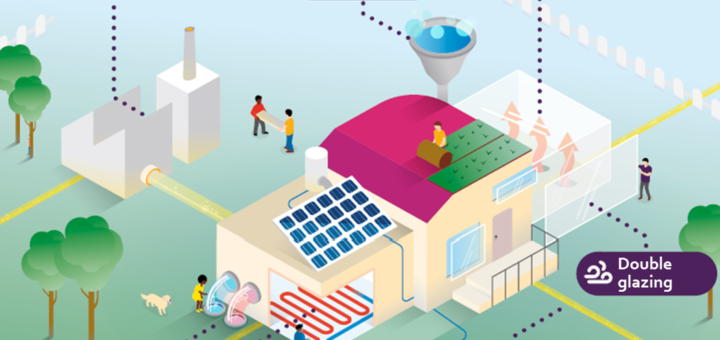About 96% of all households in the Netherlands are heated using natural gas and is still the European Union’s largest natural gas producer. The demand for heat will have to be filled in another way than using natural gas and lot of existing buildings will need to be retrofitted. The transition will also have huge social implications, as it will affect the houses of seven million households in the Netherlands.
In the framework of the EU-funded PUBLENEF project, partners across the European Union support municipalities and regions in their energy transitions, with a focus on energy efficiency. Project partner JIN Climate and Sustainability supports the Dutch municipality of Midden-Drenthe in its ambition to become energy neutral. The municipality aims to reduce local energy demand, while ensuring that the remaining energy consumption will be fully locally (or regionally) generated without a carbon footprint. In the process, there is a specific focus on heat energy, which makes up more than half of the municipality’s energy use.
Heat energy transition
Looking at the ambition to become energy neutral, a distinction can be made between three energy carriers: electricity, heat, and transport fuels. With wind and solar energy capacities expanding year-on year, the transition in the electricity system has already reached a certain level of maturity. Influencing the transition in transport fuels is considerably more challenging, particularly since municipalities have a lower degree of (policy) influence on the mobility sector.
Most heat in the Netherlands is generated using natural gas, with about 96% of all households being heated using natural gas. The Netherlands (still) is the European Union’s largest natural gas producer. This mainly is because of the Groningen gas field, the largest on-shore natural gas field in Europe. However, the end of the gas production is in sight, as reserves are steadily declining. On top of that decades of onshore gas extraction has started to induce a rise in earthquakes, particularly in the Northern part of the Netherlands. Thus far the most severe induced earthquake in the North has been at 3.6 Richter scale, which is quite high in a country that is not located near any major fault line of the tectonic plates. This also makes that large-scale gas production is no longer considered socially acceptable. Apart from lowering gas consumption to reduce greenhouse gas emissions, additional (political) drivers for the heat energy transition include maintaining energy security, lowering (future) import-dependence of natural gas, and earthquake prevention.
Heat transition target for Midden-Drenthe?
Within Midden-Drenthe under a ‘business-as-usual’ scenario, about 1.1% of the total housing stock of about 14.000 is replaced annually, through demolition and/or new construction. This usually contributes positively to the energy performance of the housing sector, as demolition often involves older buildings, while newly constructed houses have to comply with the latest building standards with regard to energy performance.
Assuming that the rate of demolition and new construction remains constant, most of the heat transition would involve conversion of the existing building stock. Considering that an average house is substantially renovated once per 45-50 years, about 2.25% of houses in Midden-Drenthe are renovated annually. If the municipality ensures that the heat transition is included in all new construction and all renovations, about 3.35% of the building stock can undergo the transition every year, which would mean that in some 30 years the entire local housing stock can be converted.
Alternatives and way forward
Based on the above mentioned developments, the demand for heat will have to be filled in another way than using natural gas. A lot of existing buildings will need to be retrofitted. The transition will also have huge social implications, as it will affect the houses of seven million households in the Netherlands.
First and foremost, the heat transition requires major investments in both energy efficiency and energy savings measures. Roof, floor, wall insulation, double glazing, etc. will all be needed to bring down the heat consumption. After that, alternative heat generation and supply systems will need to be embedded in the energy system to enable the replacement / phase-out of gas-based equipment. There are numerous options for alternative heat supply, including heat pumps, district heating, block heating, wood/pellet stoves, solar boilers, geothermal, heat storage/buffering, biogas, renewable gases, etc.
The PUBLENEF project aims to assist Midden-Drenthe in the process to become energy neutral in the area of heating. The support will focus on helping the municipality and other relevant local stakeholders to inventory and identify the specific local preferences with regards to efficient and alternative heating systems. Aside from helping in the local preferences, there will also be a need to assess which contextual factors (demographic, social, economic and environmental) influence the capability and willingness of individuals or organisations to invest in the heat transition from the bottom-up. A key ingredient in this process will be to seek meaningful and effective collaboration with existing social networks in the neighbourhoods, villages and countryside, such as the district council, house owner associations, sports clubs, etc.
A longer version of this article has been published in the JIQ Magazine issue of October 2017. More information on this and other ‘roadmaps’ of the PUBLENEF project is available on the PUBLENEF website.

This article is an output of the EU-funded PUBLENEF project, that aims to assist European Union Member States in implementing effective and efficient sustainable energy policies (with the focus on energy efficiency).
PUBLENEF
Project details
- Project title: “Support Public Authorities for Implementing Energy Efficiency Policies” (PUBLENEF)
- Funding scheme: European Union Horizon 2020 Programme (EU H2020, grant agreement no. 695923)
- Duration: 3 years (1 February 2016 – 31 January 2019)
- Project coordinator: JIN Climate and Sustainability, Groningen, Netherlands
- Project website: www.publenef-project.eu

